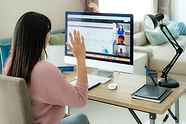Self-Recording Options
The Center for Teaching and Learning (CTL) highly recommends that you record with CTL to produce high-quality and accessible course materials; however, it may not be feasible for you to do so by CTL’s recording deadlines. In the event that you must self-record, here are some options you might consider. Additionally, please make sure to read the information on transcribing self-recorded video and audio.
NOTE: If you record, or capture, a class session you must adhere to FERPA. We recommend -- especially if you capture any student names, audio, video or other likeness -- that you share the recording only with the enrolled students whose class was recorded. Please review the university guidelines for recording class meetings for further guidance.

Zoom
Zoom is a robust web conferencing presentation software that's freely available to anyone. Both free, basic accounts and paid, licensed (formerly called Pro) accounts under the Johns Hopkins Enterprise Zoom agreement can be provisioned through the Johns Hopkins IT Service Catalog. Note that free accounts allow for only local, not cloud, recordings. (See the Johns Hopkins Zoom FAQ and Zoom's plan comparison to see the variation between other features at the different account levels.) Lectures recorded with Zoom can be shared through CoursePlus.
Zoom recordings can be quite versatile and include screen sharing, audio and webcam video (gallery or spotlight views) of speakers, and even multimedia files. If you are using Zoom as a lecture alternative, please see Using Zoom to Create a Recorded Lecture.
Screen Capture
Screen capture, or screencasting, is the process of recording your computer's screen as you actively navigate through a document or program. This can be especially helpful if you want to demonstrate something on your screen, such as a particular program or the “real-time” results of a variable being introduced. However, it is also a perfectly viable alternative to an audio + PowerPoint presentation. Audio narration (and, optionally, video of the person speaking at the same computer) can be simultaneously recorded as the screen is captured, or it can be recorded separately and then "layered" into screen capture video using special software.
While there are free and low-cost online tools for screen capture, such as Screencast-o-matic or apps for Apple iOS and Android devices, these are usually limited in their editing and export capabilities (e.g., the free version of Screencast-o-matic limits each recording to 15 minutes and puts a watermark on the video). Ideally, a lecture alternative should be created using professional software, such as Camtasia (by TechSmith), which has purchasing guidelines in the Johns Hopkins Software Catalog (JHED ID required for login). Note that if you opt to use screen capture software and need help learning the tool, you will need to refer to the manufacturer's website or a tutorial resource such as LinkedIn.
If you want to use "free to you" (as a member of the Johns Hopkins community) resources for screen capture, CTL recommends Zoom or Microsoft Stream.
Panopto
Another self-recording option gaining momentum at the Bloomberg School of Public Health is the Panopto video platform. Johns Hopkins has an enterprise subscription to this service. The software allows for lecture capture as well as independent screen capture. If you are creating a true lecture capture, it bears repeating: please follow the university's guidelines for recording class meetings so as not to unintentionally violate student privacy rights.
If you are using Panopto as a lecture alternative, please see Using Panopto to Create a Recorded Lecture.
PowerPoint
One self-serve option that is not quite screen capture but allows you to create narrated slide presentations, even with a webcam ("cameo") video overlay, is Microsoft PowerPoint. PowerPoint allows you to export your narrated presentation as a video. When you're creating your recording you even have the option of adding visual annotations, such as "laser pointer" gestures or digital stickers or drawings, to the PowerPoint video.
If you are using PowerPoint as a lecture alternative, please see Using PowerPoint to Create a Recorded Lecture.
Audio-Only (MP3) Tools
CTL recommends the tools Record MP3 Online and Online Voice Recorder, because they are free, do not require any software to be installed, and are very straightforward and easy to use. There are certainly other tools available—both free and paid—that you may come across. Regardless of the tool you use, your final recording should be saved as an MP3 file. Once the MP3 audio file is saved, it can be shared with students through the CoursePlus course site.
For tips on recording an audio-only lecture on your own, view our Recording Tips document.
Required Transcription
Providing transcripts or closed captioning as accessible alternate formats of videos being shared with a class is in accordance with University-wide guidelines: all course materials must be digitally accessible. This applies to all resources created by faculty on or after January 1, 2021. Students should also be encouraged to include a transcript or captioning when sharing their videos as part of an assignment, especially when shared with classmates.
For videos shared using a direct link to Panopto, the Zoom cloud portal, or Microsoft Stream, the single hyperlink to the video will allow for automatic, interactive captioning. Learn more:
For any video that does not have automatic transcription available, including Zoom meetings that are recorded locally (to your computer), the transcript must be obtained by a third-party service. One option is to use Microsoft Stream. This web app is a part of Microsoft 365. All Johns Hopkins affiliates with access to Office 365 can use this service for free.
To produce a video’s transcript using Microsoft Stream, you can refer to this guide: Using Microsoft Stream as a Transcription Service [.pdf].



